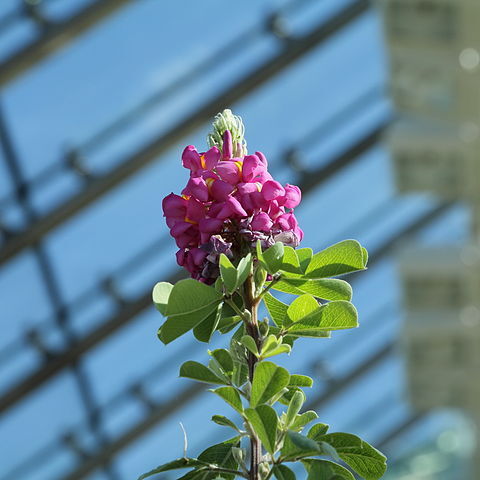A much-branched shrub usually 1-3 metres or more high, seldom a basally unbranched tree up to 4 or rarely 6 m high. Branches dark, longitudinally striated or somewhat sulcate, ends sparsely tomentose or villous. Leaves. Stipules subulate, usually 1.0-4.0 mm long, often later falling off, sub-glabrous or more or less hairy on the inner side. Petiole straight, rigid, firmly suberect to erect, varying in length from less than 4 mm to more than 13 mm, glabrous or rarely hairy. Leaflets with petiolule 0.5-3 mm long; lamina oblanceolate to obtriangular-obovate, 9-30(-40) x 6.5-18(-22) mm, narrowly cuneate at the base, obtuse or usually distinctly obcordate at the apex but with an acute to subulate point occasionally up to 1.5 mm long. Upper surface of leaflets glabrous, rather smooth, with faintly reticulate veinlets, canaliculate along the midvein; lower surface paler, with prominent midvein, subglabrous or very sparsely tomentose. Lateral halves of leaflets often folded up against each other, the upper surface thus being not or slightly exposed. Inflorescence a dense, terminal raceme with generally more than 30 flowers borne only 1 mm or less from each other on a sparsely to densely tomentose axis. Raceme first spike-like and obtusely pyramidal, the buds in the apical part being closely set and greatly exceeded in length by the setaceous-filiform bracts; inflorescence later ovate and bracts gradually shed as anthesis proceeds. Bracts setaceous, tapering, filiform towards the apex, 9-15(-18) mm long and 1.0-2.2 mm broad, caducous (see above), pubescent at least on basal parts and margins, sometimes with sub-hyaline margins in the basal half. Pedicel usually 6-13 mm long during anthesis, rather slender, sparsely villous but glabrous towards the calyx. Bracteoles situated near middle of pedicel, filiform, usually 3.5-7.5 mm long, pubescent. Calyx externally glabrous, reddish, smooth, campanulate in the bud stage but with the basal parts drawn backwards towards the onset of anthesis. Upper two lobes joined medially into an upper 'double lobe' up to a point only 0.3-0.6 mm from the apices; lateral incisions deeper, especially the lower ones; lobes triangular, the lowest, median lobe 1.5-2.6 mm long. Petals glabrous, purple, but the vexillum blade centrally with a basal, large, light-yellow, violet-shaped spot. Vexillum blade circular, usually 11-13.5 x 11-15 mm in size, rounded at the apex, with the sides slightly deflexed during anthesis; claw short, about 1 mm long or less, with lateral callus discs c. 0.8 mm in size. Alae blades elongate, widened and rounded towards the apex, 11-14.5(-15.5) mm long and 4.5-7.0(-8.0) mm broad at the widest part; basal half with a main longitudinal fold and on the upper part with some rather slight transverse to oblique foldlets; claws usually 1.5-3.2 mm long. Carina blades lunate, somewhat beaked, 9.0-11.5 x (3.6-)4.0-5.0(-5.4) mm in size; claws 2.0-3.2 mm long. Stamens: Basifixed anthers 0.9-1.1 mm and dorsifixed ones about 0.7-0.9 mm long. Pistil: Ovary with 5-8(-12) ovules. Fruit a linear legume usually 3.5-6.5 cm long and 4-6 mm broad, rather smooth, with distinct convexities for the (4-)5-6 seeds that mature, first pea-green, later reddish brown to almost black. Seeds dark brown to almost black, ovoid, 4.0-4.8 X c. 2.5 mm.
More
Shrub or small, reseeding or resprouting, tree-like shrub to 6 m. Leaves 3-foliolate, erect, leaflets obcordate-cuneate, apiculate. Flowers 30-more in dense, terminal racemes, magenta with yellow nectar guide, calyx glabrous. Pods narrowly oblong, almost segmented between seeds.


